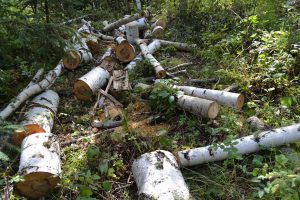It was a lovely, picture-perfect day to go out into the woods up the hill and create some future firewood that hadn’t fallen yet.
I started on a couple of standing-dead aspen that were just a little beyond my usual distance for hauling. I am always skeptical about aspen that are already dead. They seem to begin rotting before they actually die, so that when they are clearly dead they can already be getting punky. These were a couple of nice-looking ones, though, so I thought I’d give it a whirl. The first one came down perfectly, but after some dicing from the bottom up it became borderline punky as I went up, so I tried the next one.
This one didn’t go down as planned. In fact, all of a sudden I was through the base and it just did a little drop and stood there. On the sawbar. I stepped back to look things over. It was dead calm out, and the tree’s branches were entangled with a live one up at the top. I leaned into it, and it moved a little—just enough to let me ease the saw out. It wasn’t safe to cut there anymore, so I walked back down the hill. Just as I reached the bottom, I heard it creak and fall—but it sounded like it only went partway down. Hiking back up, I found this to be the case, so I left it again and went down a ways to solve an earlier problem.
That’s when the real fun began. A couple of weeks ago an aspen had fallen in a wind storm but had gotten hung up in the fork of an old birch. I can usually bring these things down by repeatedly cutting off four-foot pieces from the base, walking up the length until it finally comes free from higher entanglements. This one, though, had really hung up in the old birch, and it had hung with its base four feet in the air for a couple weeks. This birch had lost its top and most upper branches over the past few years, and I figured it was going to come down next year anyway, so I decided to hasten its demise and get the rest of that aspen while they were both still perfect firewood.
It turns out that a tree can fall in an unpredictable way when it is burdened by half of another tree hanging from it. It did not go down as I’d planned. Instead, it slowly pirouetted about 20 degrees from where I’d aimed and took out what I’d considered to be its smaller replacement birch nearby. And the big birch, too, hung up in neighboring trees. So there I was standing beside a big, creaking mess. A long, large branch had been hanging from the big birch, too, so there were fully four tree stems (becoming five higher up) trying to go in different ways under relentless gravity. With the bent-over young birch in the middle of it all trying with creaks and groans to spring back up again, I had to be careful with every cut.
So I waded in and began taking four-foot sections off the base first of the birch, then also of the hung-up aspen. I hoped the bent-over birch would be able to recover and so left it for awhile, but the creaks and pops it was giving as it strived to spring back sounded increasingly unhealthy.
It’s great to get the excellent firewood that a big birch can produce, and this was a beauty. But talk about heavy. Each four-foot piece was coming free easily until I reached the fork created by the last big straight-up branch and the main bole, which was broken off higher up. Although I completed the cut through the two pieces, the whole precarious setup just stood there. Usually I’d set the saw down out of the way and take up a cut piece and throw it at the juncture to pop it all loose, but I was not going to do that with the big four-footers at my feet. So I pivoted and gave it a big kick.
In (thankfully) fairly slow motion, the big branch came loose and slid right for my leg. I pivoted again and jumped out of its way but hadn’t paid close attention to the other, bigger piece of the tree. It did something totally unexpected: its base swung away from the cut and hit the ground just far enough away to reverse its balance, and it tipped back my way and came crashing down with a resounding boom right where I’d just been standing. If I’d still been there, I’d have been smashed like a bug. It was a good reminder to keep your eyes peeled and have an escape route planned. I stepped back into the carnage and began cutting the big pieces into 16-inch stove lengths. The bent-over birch didn’t spring back, so it joined its brethren on forest floor, diced up for the woodstove for next winter. I don’t think I’ve had such a concentration of wood in one spot before. It was a heck of a mess.
* Rose came up with the title phrase after asking “How did it go?” and I told her.


Cheating the Widowmakers
That’s a term I think of often when I’m out doing that. (Widowmaker, not cheating.)